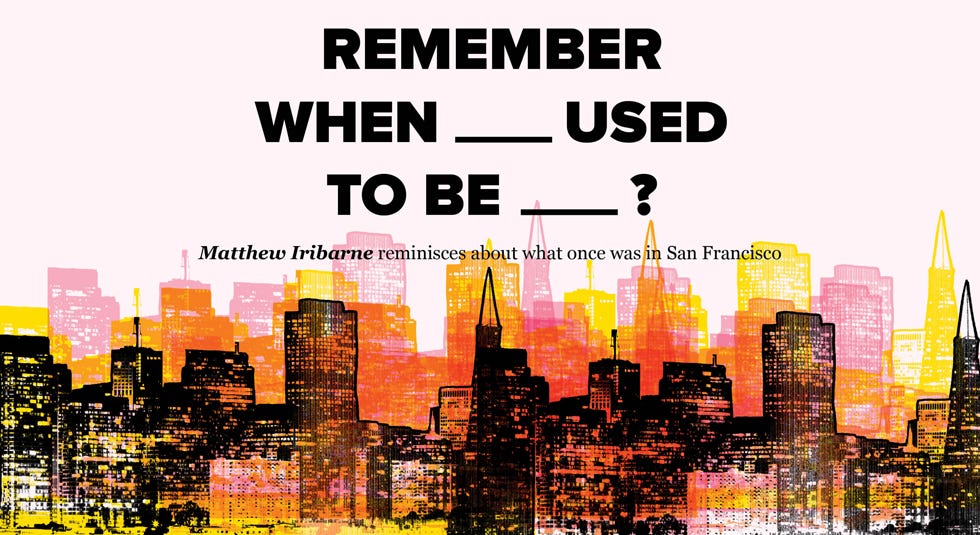
By Matthew Iribarne
The city has changed a lot in these past 20 or so years. And yes, everything changes. Time may change me, but I can’t trace time. Then again, maybe I can trace it, just a little. Here’s a breakdown of some of the places in San Francisco that I once frequented — what they were and what they are now, these occasional secret histories that surround us.
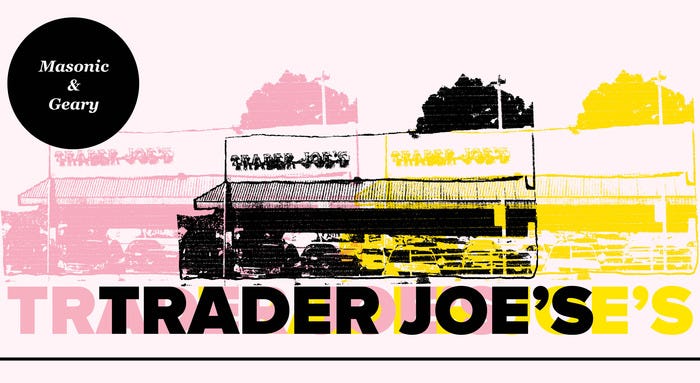
Trader Joe’s once was a gigantic paint store called Standard Brands Paint Company (1977–1996). There are still traces of what the place was if you consider the actual layout of the building. That is, its warehouse-like configuration, the high ceilings. Not long after I moved to San Francisco I came here to buy paint. Next door to Standard Brands Paint Company was the Copper Penny restaurant that at some point in the 1990’s changed its name to the Lucky Penny. Well, I guess it wasn’t that lucky, because now the Lucky Penny stands empty and is set to be demolished, the site of a proposed seven-story mixed-use building. In other words: condominiums. But let’s try to remember this restaurant that had been around since the 1950’s: the Lucky Penny that was once the Copper Penny that served patty melts and Caesar salads, apple pie and black, black coffee. There was a Sears across the street (that eventually became a Mervyn’s and is now a shiny red and white Target). People would shop for paint at the Standard Brands Paint Company, or for clothes and appliances at Sears, come to the Copper Penny before or afterward. I imagine the vinyl seats and the Formica tables. There’s cigarette smoke. Everyone is talking and there are families and housewives and college students, old-timers and young couples and housepainters and accountants. A coming together. Those with some money and those with very little money too. The United States of the Copper Penny and the Lucky Penny, Sears across the street and the Standard Brands Paint Company.
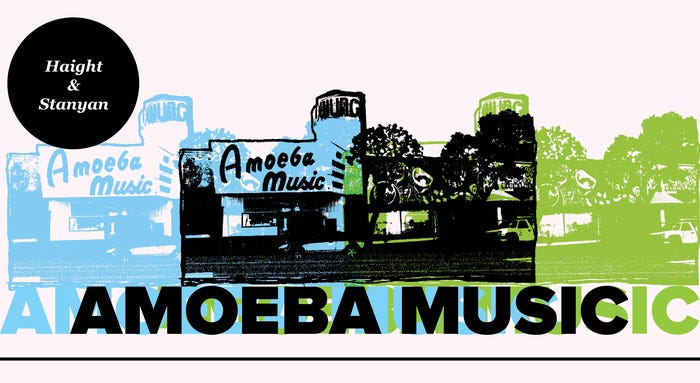
Here there was once a bowling alley called Park Bowl (1950–1996). The Park Bowl was home to the Rock and Bowl, which played extremely loud rock music while people bowled. Once it was a simple bowling alley, but
then it tried to become something more. This something more involved laser beams and rock videos. What was the point? Bowling was bowling, who needed all those bells and whistles and bowling pins that glowed? Apparently, the kids, but even the kids weren’t so keen on such things because the Park Bowl eventually closed its doors. Then along came this record store called Amoeba, and we all know that kids love buying records, right? Which brings us to…

This Walgreens was once a Tower Records (1967–2006), as evidenced by the parking lot mural with paintings of Janis Joplin and Jerry Garcia and the eternal words — go on, just sing it — “City by the Bay.” After it was a Tower Records it became a dry cleaning company before morphing into a Walgreens, which is what too many places morph into these days. But I’m not going to name all those places that were once something else that became Walgreens. I’m just going to say that it’s funny to think that this place, in the aisle where they’re selling Vagisil, is where Evan Dando of the Lemonheads once played an unplugged set somewhat hung over and all sleepy-faced, while my then girlfriend and I watched and listened with maybe 14 or 15 other people.
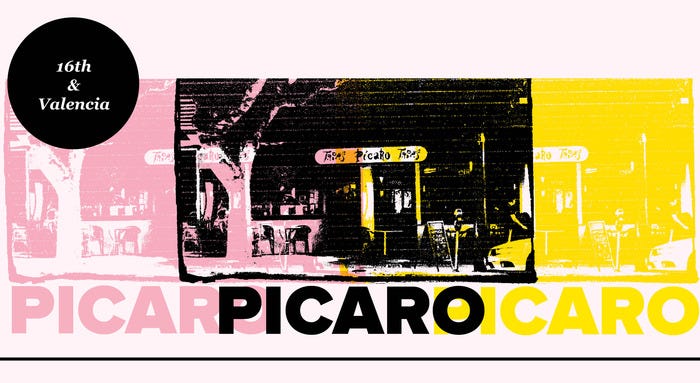
I’m not talking about the tapas bar, but the café. Does anyone remember Café Picaro (1980–1995)? Everyone smoked. People read books and scribbled into their journals, read aloud their poetry. All this while the mariachi band stopped by every night to play a few songs. The wooden tables were banged up and oversized and the coffee was strong. Let’s not forget The Red Man. He would sit at his table wearing his suit with his hair slicked down and his skin painted red. He had a pencil thin mustache. His eyes were lined black. He looked like a cross between Salvador Dali and Cruella de Ville and I couldn’t take my eyes off of him. Once he spoke to me. Told some joke I didn’t understand and asked if I had a cigarette. Then he seemed to float away, gone as soon as he’d appeared. Not long after, Café Picaro disappeared as well, along with too many other neighborhood places. One can’t help but wonder what The Red Man would have made of all these new bars and restaurants, the Mission suddenly a destination area. And maybe that was the joke. That time was funny — places changed into other places and in just a few years the Mission would be more different than we could ever begin to know.

Bija Yoga was once a bookstore called Ninth Avenue Books (1982–2002) and there isn’t room here for all the bookstores I used to buy books in that are now yoga studios. Or boutiques. Or, yes, Walgreens. But this was where I’d go to do a good amount of my book shopping. I discovered Mavis Gallant here. Not to mention Richard Brautigan. The bookstore had something called a nook, as well as a cranny, one section melding with another, which made for some interesting surprises. That is, books you would never come across otherwise, the accidental find. And it makes me cry to think about how these kinds of discoveries don’t get to happen so much anymore. The world a little more organized and incomplete. Everything less random, in its right place.
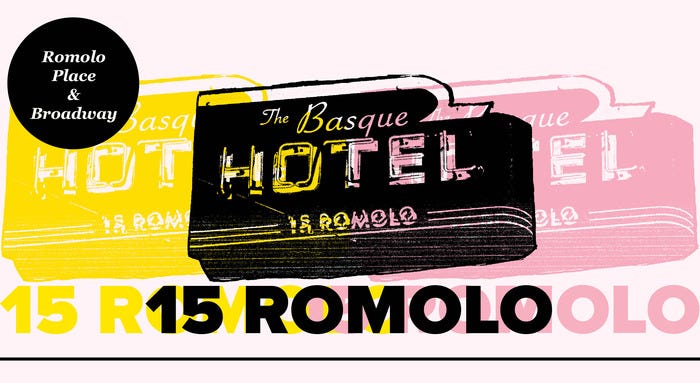
15 Romolo used to be the Basque Hotel Restaurant (1964–1996). It’s now a bar, not so much a hotel, and I can get a little emotional when I write about this place because, well, I’m Basque. Also, there’s the fact that I have so many fond memories of this restaurant. The long communal tables where the patrons ate together, family style. The Picon Punch, orangish and tart, one glass was never enough. The food, depending on what day of the week it was, could be trout with lemon sauce, leg of duck or oxtail stew, Chicken Basque. Soup came first, salad last, wine was everywhere. The portions were generous and always, always, always, there were French fries. Years later I set foot inside 15 Romolo and asked the poor doorman where the hell the restaurant was, even though I knew it was gone. He said there was still the hotel, but that it wasn’t really a Basque hotel. So then, why was it still called the Basque Hotel? He didn’t have an answer. And what could he say? What could anyone say? It’s just another place that’s gone and transformed from one thing to another, it happens everywhere. Time moves on. History is told through the memories of those of us who were there. Seals Stadium. Winterland. Playland at the Beach. The list goes on and on.
Maybe that’s why these places harbor so much in the way of memory. It’s like we have so little here that we can hold onto in San Francisco. There are so many people coming and going. The memories of such places offer some kind of mooring, a way of feeling connected to a past that too often seems gone before it even happens. So then, why not dwell on these things sometimes, if we can? Why not recall these places that once were, the people who were there? I just want to remember, is it so wrong? Let’s remember together.
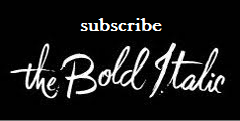
Designed by Brian Standeford







